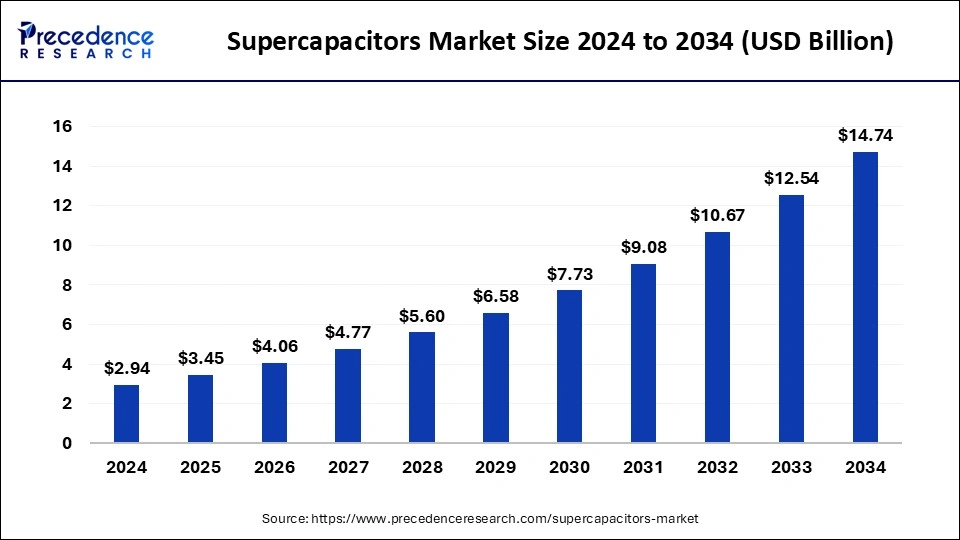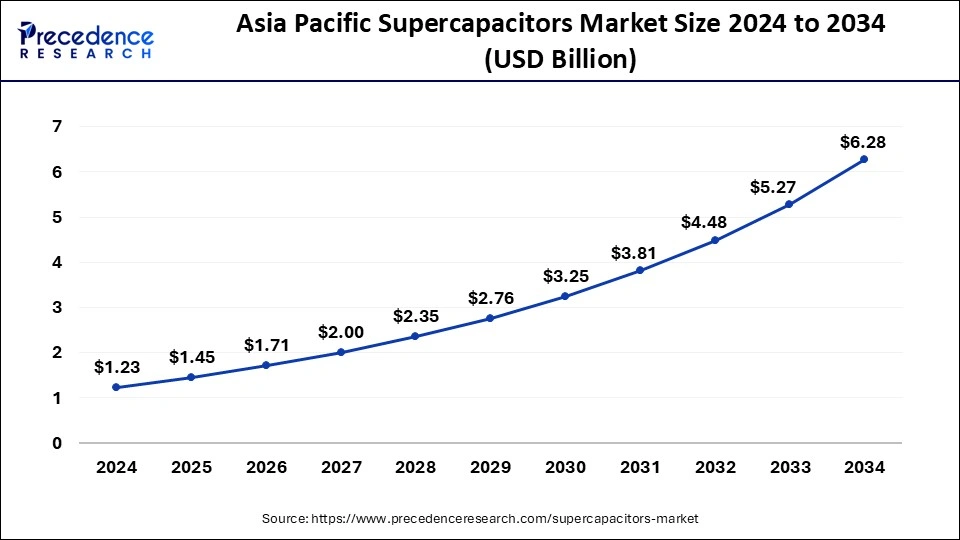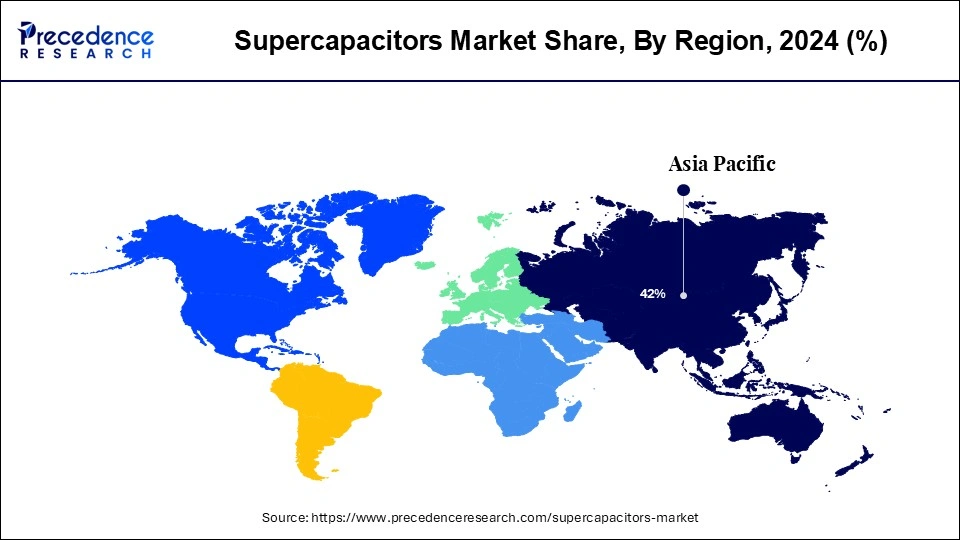List of Contents
What is the Supercapacitors Market Size?
The global supercapacitors market size is estimated at USD 3.45 billion in 2025 and is predicted to increase from USD 4.06 billion in 2026 to approximately USD 14.74 billion by 2034, expanding at a CAGR of 17.50% from 2025 to 2034.

What is a Supercapacitor?
Advanced advances in storage technology with emerging market segments such as hybrid electric vehicles (HEV), smart grids and renewable energy systems and the capacity of supercapacitors to provide emergency shutdown power or backup to low-power equipment such as RAM, SRAM, microcontrollers and PC cards are the major driving factors for the global supercapacitors market. However, the factors expected to hamper market growth are high initial costs of materials and poor knowledge of supercapacitors. In addition, an increase in demand for newer solar and wind energy applications and an increase in demand for micro supercapacitors are expected to provide lucrative prospects for the future growth of the supercapacitor industry.
What is the Role of AI in supercapacitors?
Artificial intelligence, being the facilitator of this modern sector, accelerates material discovery processes, predicts electrode-electrolyte compatibility, and ensures manufacturing precision. AI-based automation guarantees consistent quality and lower waste generation. Real-time monitoring based on AI determines reliability and dynamically controls the life of the product. Performance-based analytics driven by AI ensure optimization of products and sustainability, based on the support of biodegradable materials. Supply chains in India can be refined by AI subjects, reducing the cost factors to make commercially viable advanced supercapacitors. In fostering innovations would uphold course in automotive, renewable energy, and industrial applications, whose primary rationale is accelerating and evolving supercapacitor market growth with the greater efficiency potential and sustainability agenda.
Market Outlook
- Industry Growth Overview: The supercapacitors market is growing, driven by rising demand for energy storage in e-vehicles, renewable energy technology, and consumer electronics. Incorporation in electric and hybrid vehicles for regenerative braking and power stabilization.
- Global Expansion:The supercapacitors market is experiencing global expansion, as growing requirement for efficient energy storage solutions for renewable energy systems and electric vehicles (EVs). Asia Pacific is dominated in the market by growing industrialization, the proliferation of customer electronics manufacturing.
- Major investors:Major investors in supercapacitor technology include massive industrial corporations, investment funds, and organizations that use the expertise in their own products, like electric vehicles and industrial systems.
Supercapacitors Market Growth Factors
- The rising demand for supercapacitors for use in regenerative braking and hybrid energy systems due to escalating EV adoption improves vehicle performance and battery efficiency.
- Integration with renewable energy systems stabilizes the grid as supercapacitors provide front-end energy storage and quick energy release.
- Further technological advances in materials, incorporation developments in electrode design, etc., shape energy density improvements, cost improvements, and cycle-life improvements.
- Government incentives for electrification and energy efficiency provide a favorable opportunity for establishing wider acceptance of supercapacitors.
- The expanding use of industrial and consumer electronics supplies demand as they require instantaneous power, high reliability, and long life.
Market Scope
| Report Highlights | Details |
| Market Size by 2034 | USD 14.74 Billion |
| Market Size in 2026 | USD 4.06 Billion |
| Market Size in 2025 | USD 3.45 Billion |
| Market Growth Rate from 2025 to 2034 | CAGR of 17.50% |
| Dominating Region | Asia Pacific |
| Base Year | 2024 |
| Forecast Period | 2025 to 2034 |
| Segments Covered | Type, Capacitance, Application, Voltage Range, Electrolyte Type, and Regions |
| Regions Covered | North America, Europe, Asia-Pacific, Latin America, and Middle East & Africa |
Market Dynamics
Driver
Innovation of supercapacitors for electric vehicles
In September 2022, India's leading lithium-ion cell manufacturer GODI announced the development of India's first ever 3000F supercapacitor that could be used for electric vehicles. This high power supercapacitor is capable of storing and releasing electrochemical energy in order to improve battery life in electric vehicles. Additionally, this supercapacitor can be used in other renewable energy sources, smart grids and UPS applications.
The development of supercapacitor for the application in electric vehicle is observed to grow in the upcoming period with the expansion of global electric vehicle market. Supercapacitors are being widely utilized in electric vehicles for fsst charging and high power density purpose. They can rapidly absorb and store energy, reducing charging times compared to traditional lithium-ion batteries. Thereby, as the demand for electric vehicles continues to grow, the development and implementation of supercapacitors in these vehicles are expected to drive the supercapacitor market.
Restraint
High cost of production
The production process for supercapacitors can be more complex and require precise control to ensure the quality and performance of the final product. As compared to other energy storage technologies, supercapacitor technology is newer in the industry, which brings limited scale of production. This creates an obstacle for manufacturers as the per-unit manufacturing cost can be high. Thereby, the cost of production is observed to act as a major restraint for the supercapacitors market. However, the market holds the potential for cost reduction as development activities increase.
Opportunity
Expansion of the renewable energy sector
The expansion of the renewable energy sector creates a favorable environment for supercapacitors. The growing interest in renewable energy technologies encourages research and development in energy storage solutions, including supercapacitors. This leads to advancements in supercapacitor technology and the creation of more efficient and cost-effective solutions. Supercapacitors are also being used in the renewable energy sector to improve the reliability of energy supply. Supercapacitors can be integrated into renewable microgrids to store and supply power efficiently, especially in remote or off-grid areas.
Segmental Insights
Type Insights
The Electric Double-Layer Capacitors (EDLCs) segment holds significant potential in the supercapacitors market to grow. High energy density, wide application and rapid charging are few factors that promote the segment's growth in the market. EDLCs are versatile and can be used across various industries, including automotive, renewable energy, consumer electronics, and industrial sectors. Their ability to deliver quick bursts of power makes them valuable in these sectors.
Continuous innovations in materials and manufacturing processes have improved the performance and reduced the cost of EDLCs, further boosting their adoption in the market.
Capacitance Insights
The medium (10 to 100 Farads) segment holds a notable share in the market. Medium-range supercapacitors are used in numerous applications, including backup power supplies, automotive applications (like regenerative braking and start-stop systems), and in renewable energy systems. Their flexibility to be integrated into these diverse applications drives demand.
Application Insights
Being the most prominent segment of the supercapacitors market, the automotive segment is observed to expand with the shift towards electric vehicles. Supercapacitors provide rapid energy bursts, enhancing the performance of EVs, especially during acceleration and peak loads. Supercapacitors offer a high-power density, which is crucial for applications like regenerative braking in electric and hybrid vehicles. They can quickly absorb and release energy, making them ideal for these systems.
Voltage Range Insights
The medium voltage (2.8 to 5 V) segment of voltage range offers good balance between energy density and power supply. Many electronic systems and components are designed to operate within this voltage range. This compatibility reduces the need for additional voltage conversion components, making supercapacitors in this range more cost-effective and easier to integrate.
Electrolyte Type Insights
The organic electrolytes segment carries wider voltage range and higher energy density. Supercapacitors using organic electrolytes can achieve higher energy densities because of the higher operating voltages. This makes them more suitable for applications needing compact energy storage with substantial energy output.
Regional Insights
Asia Pacific Supercapacitors Market Size and Forecast 2025 to 2034
The Asia Pacific supercapacitors market size is estimated at USD 1.45 billion in 2025 and is anticipated to reach USD 6.28 billion by 2034, growing at a CAGR of 17.65% from 2025 to 2034.

Hub for the electronics and automotive industries
Asia Pacific, with technological advancements and a growingconsumer electronics sector, is observed to expand at a notable rate. The region is a global hub for the electronics and automotive industries, both of which are significant consumers of supercapacitors. The growth in electric vehicles (EVs), hybrid vehicles, and the increasing use of electronics in automobiles have significantly boosted demand. Many governments in the region have launched initiatives to promote renewable energy and energy-efficient technologies. For example, China's focus on green energy and electric vehicles has driven the demand for supercapacitors as essential components in energy storage systems.
The super capacitor market is growing quickly in Asia Pacific as demand for electric vehicles, portable electronics, and renewable energy applications are increasing in that area. Governments in Asia Pacific are putting sustainability targets and funding in place for clean energy programs, creating a wave of advancements of energy storage technology. China, Japan, South Korea, and India are rapidly growing industrially and providing support for innovation through public-private partnerships. The region has a large electronics manufacturing base, low-cost production, and a growing population of technologically literate minds. With technology being developed through partnerships of global businesses and regional businesses, the region is positioned to be a leader in super capacitor technology.
China: Skilled labor and low costs
In China important government support, aggressive expansion in electric vehicles (EVs) and renewable energy, and a focus on industrialization and technological development. China's quick industrialization and modernization of its production base have created a large domestic market. Incessant technological developments and a focus on novelty, specifically in areas such as graphene-based materials, are allowing the advancement of higher-performance supercapacitors.

Why North America is Dominating the Super Capacitor Market?
In the last 10+ years, North America has taken the lead in the super capacitor market due to its established industrial infrastructure, continued investment in clean energy solutions, and the rapid adoption of electric mobility. North America has leading technology companies and substantial research and development programs related to energy storage systems. Additionally, North American industries such as automotive and aerospace, are increasingly deploying super capacitors or hybrid capacitor and battery storage systems in their solutions, to improve performance and reduce firm carbon emissions.
Continued spending in clean energy solutions
In North America, the United States is a clear outlier that contains an established ecosystem of manufacturers, research institutions, and technology startup companies focused on advanced energy storage solutions. Given the investments in next-generation capacitor technologies by companies like Tesla, Maxwell Technologies, and Ioxus and the leading research into energy storage technologies by institutions like MIT and Stanford, and the on-going support by the U.S. Department of Energy in clean energy storage technologies, the United States is firmly committed and investing in new technologies that are focused on energy storage.
U.S.: Support for sustainable energy
The U.S. market is propelled by the rapid acceptance of e-vehicles and the requirement for energy-efficient services in consumer electronics and industrial applications. Government guidelines, like those promoting clean energy and EVs, are increasing the demand for supercapacitors. There is a high level of investment in research and development, leading to the creation of high-performance, hybrid, and other progressive supercapacitor technologies.
Europe: Technological advancements
Europe is experiencing substantial growth in the market due to the European Union's severe carbon emission targets and an increasing focus on energy efficiency, which has led to favorable guidelines, incentives, and funding for clean technology research and development. Continuous R&D in Europe is a cause for enhanced supercapacitor performance, including higher energy density and reduced costs, which further fuels their adoption across a wider range of industries.
UK: Technological Advancements
The UK government's focus on sustainability and clean energy, through various incentives, encourages the advancement and adoption of novel energy storage technologies such as supercapacitors. The demand for long-lasting, high-power energy services in industrial automation, customer electronics, and other sectors contributes to the market growth.
Value Chain Analysis – Supercapacitors Market
Raw Material
The raw materials for supercapacitors are primarily carbon-driven materials such as activated carbon, carbon nanotubes, and graphene, as well as metal oxides like manganese, cobalt, or nickel, and conducting polymers
- Key Players: CAP-XX Limited
Chemical Synthesis and Processing
Chemical synthesis and processing for supercapacitors involve various types of techniques to create and manipulate electrode materials at the nano-scale to increase their surface area, improve conductivity, and enhance electrochemical performance.
- Key Players:Eaton and Nesscap Energy
Compound Formulation and Blending:
Compound formulation and blending for supercapacitors refers to the process of combining and merging different materials to create the electrode slurry and composite materials, which form the core of the device.
- Key Players: Panasonic and Maxwell Technologies
Top Vendors in the Supercapacitors Market & Their Offerings
|
Company |
Headquarters |
Key Strengths |
Latest Info (2025) |
|
Carolina, USA |
Technological innovation |
The new SpiCAT (SpiSCAP) online engineering simulation software makes it simple for engineers to evaluate and select SCC and SCM Series supercapacitors designed to overcome common power challenges. |
|
|
Japan |
A diverse portfolio spanning consumer electronics |
In February 2025, Panasonic Industry is expanding production of its larger hybrid capacitors as demand ramps up for power supplies in AI datacentres. |
|
|
Cap-XX Limited |
Australia |
Superior Power Delivery |
CAP-XX is a leader in the design and manufacture of thin, flat supercapacitors and energy management systems |
|
SPEL Technologies Private Limited |
Pune, Maharashtra |
Increasing research and development for advanced energy |
SPEL is a manufacturer of supercapacitors that can be used across a host of services and solutions. |
|
Nippon Chemi-Con Corporation |
Japan |
World-leading technological and R&D capabilities |
Nippon Chemi-Con offers electric double-layer capacitors, which are suitable for kinetic energy capture. |
Major Key Players
- Skeleton Technologies
- Ioxus Inc., LS Mtron Ltd.
- Evans Capacitor Company
- KORCHIP Corporation
- Nesscap Energy, Inc.
- Advanced Capacitor Technologies, Inc.
- Maxwell Technologies
- FastCAP Systems, Inc.
Recent Developments
- In June 2025, Energy storage firm Skeleton Technologies has launched GrapheneGPU, a peak-shaving capacity shelf that ditches Lithium for supercapacitor energy storage based on Skeleton Technologies' patented Curved Graphene technology. (Source: https://www.datacenterdynamics.com)
- In May 2025, ATX Networks, introduced its new Areca™ Hybrid Supercapacitor Group 31 Energy Storage Modules. Designed to meet the demanding energy storage needs of communication service providers, the latest Areca energy modules provide a safe, compact and long-lasting alternative to lead-acid and lithium-ion batteries.
(Source:https://www.businesswire.com) - In June 2025, Allotrope Energy developed Lignavolt supercapacitors with a 14-15 Wh/kg energy density, enhancing energy recovery and power output in hybrid-electric vehicle systems.
(Source: https://chargedevs.com) - In January 2025, Researchers from Korea, France, and Japan developed a solar-powered faradaic supercapacitor with a graphene layer, achieving a 63% energy efficiency and a power density of 2,555.6 W kg.
(Source:https://www.graphene-info.com)
Segments Covered in the Report
By Type (Volume in Units)
- Electric Double-Layer Capacitors (EDLCs)
- Pseudocapacitors
- Hybrid Capacitors
By Capacitance(Volume in Units)
- Low (< 10 Farads)
- Medium (10 to 100 Farads)
- High (Above 100 Farads)
By Application(Volume in Units)
- Automotive
- Regenerative Braking Systems
- Passenger Vehicles
- Commercial Vehicles
- Start-Stop Systems
- ICE Vehicles
- Hybrid Vehicles
- Power Assist
- Electric Vehicles(EVs)
- Hybrid Electric Vehicles (HEVs)
- Others
- Regenerative Braking Systems
- Consumer Electronics
- Backup Power
- Smartphones and Tablets
- Laptops and Portable Devices
- Power Management
- Wearable Devices
- Smart Home Devices
- Backup Power
- Energy
- Renewable Energy Systems
- Solar Power Systems
- Wind Power Systems
- Renewable Energy Systems
- Grid Stabilization
- Frequency Regulation
- Load Leveling
- Frequency Regulation
- Industrial
- Uninterruptible Power Supplies (UPS)
- Data Centers
- Industrial Equipment
- Power Conditioning
- Electrical Grid
- Manufacturing Equipment
- Others (Emergency Lighting, etc.)
- Uninterruptible Power Supplies (UPS)
- Aerospace & Defense
- Power Systems
- Avionics
- Spacecraft
- Military
- Communication Systems
- Weapons Systems
- Power Systems
- Healthcare
- Medical Devices
- Portable Medical Equipment
- Implantable Devices
- Portable Medical Equipment
- Emergency Medical Systems
- Medical Devices
- Telecommunications
- Network Equipment
- Base Stations
- Data Routers and Switches
- Consumer Electronics
- Network Equipment
- Others
By Voltage Range(Volume in Units)
- Low Voltage (up to 2.7 V)
- Medium Voltage (2.8 to 5 V)
- High Voltage (Above 5 V)
By Electrolyte Type(Volume in Units)
- Aqueous Electrolytes
- Organic Electrolytes
- Solid Electrolytes
By Region
- North America
- Europe
- Asia Pacific
- Latin America
- MEA
For inquiries regarding discounts, bulk purchases, or customization requests, please contact us at sales@precedenceresearch.com
Frequently Asked Questions
Ask For Sample
No cookie-cutter, only authentic analysis – take the 1st step to become a Precedence Research client



